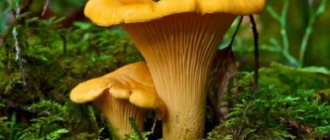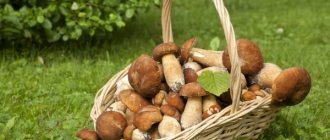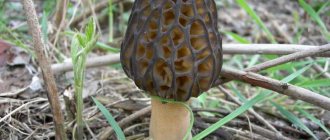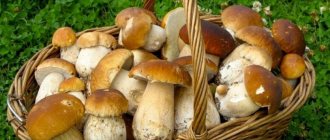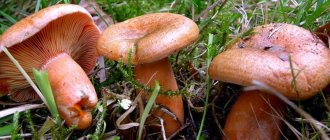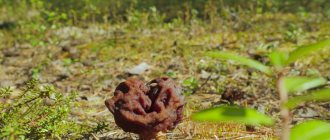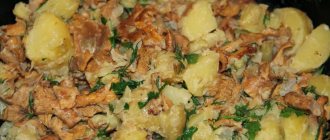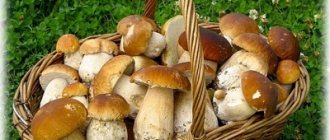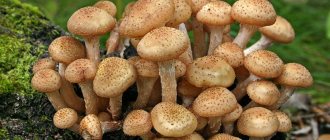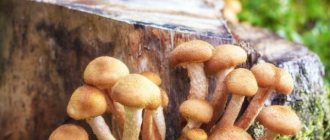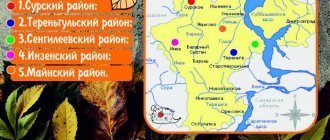Beginning the quiet hunting season, bright and long-awaited - we meet chanterelle mushrooms in the Moscow region and not only. Where they grow, when the harvest time begins, places relevant for 2022. Note to the mushroom picker: mushroom forests in the Moscow region, two dates, when is the best time to collect and how to collect correctly - subtleties from mushroom lovers and professionals.
Common chanterelle
She is a real fox , a yellow fox , a cockerel . Very recognizable and massively collected.
Description
Its fruiting bodies are bright yellow or orange-yellow in color. When young, they have convex caps, which bend inward as they mature, becoming more and more funnel-like. Diameter - from 2 to 12 cm. In young mushrooms, the edge of the cap is even, smooth, in mature ones it is wavy, bizarrely curved, or even somewhat frayed. The leg smoothly turns into a cap, diameter - from 1 to 3 cm, height - up to 7 cm.
Photo 2. Common chanterelle.
The pulp is dense, fibrous in the stem, in the center of the fruiting body it is light, more creamy than yellow, but towards the edges it gradually acquires the color of the skin.
Overripe fruiting bodies begin to decompose and darken at the edges of the cap, and it is clearly visible what can be cut off and thrown away, and what can be put in a basket.
Fruiting places, harvest time
The common chanterelle is found everywhere in coniferous and mixed forests, forms mycorrhiza [1] Mycorrhiza is a union of a fungus and a tree, thanks to which the first receives nutrients, and the second absorbs water better. with various types of trees, but especially prefers to enter into symbiosis with pine , spruce , oak , and beech . The fruiting season is from the beginning of June to October , but mushrooms usually appear at their best closer to July.
Photo 3. Typical chanterelle place.
They can be found in forest litter, grass, and moss. As a rule, several fruiting bodies emerge in characteristic “witch circles.” And often close to the found cluster of mushrooms there is more than one of the same kind.
Taste qualities
Chanterelle has an aroma that is referred to in reference books as fruity. However, in my humble opinion - it is quite similar to dried chili peppers with some hints of dried apricots. The taste in its raw form is quite pleasant, with a slight sourness (which is neutralized by heat treatment).
Chanterelle works best when fried - with onions and dill; it can also be stewed in sour cream - with the same onions and a small amount of crushed garlic and other spices. It also makes excellent caviar. But for soup (in my opinion) it is not very suitable, because it does not boil so well, therefore, it does not give a richness, like sponge mushrooms - boletus, redhead and obabki. Although, it also turns out pretty good.
Some gourmets praise pickled chanterelles, but I haven’t tried them (in general, I don’t like such preparations - where the original mushroom taste is overwhelmed by vinegar and spices).
Something about quinomannosis
Hinomannose is a pesticide substance contained in chanterelles - a terrible poison in its effect for arthropods and helminths, but absolutely harmless for mammals and humans. That is why these mushrooms almost never contain worms. Wormy chanterelles can only be found in dry and some abnormal years with few mushrooms - when the boogers simply have nothing to eat.
I remember one typical “Ural summer with little snow.” The weather was cold throughout June—therefore, there were no mushrooms during the month. When it became more or less warmer, the chanterelles were the first to emerge in our forests. That’s when all the pretty hungry flying-crawling small fry pounced on them - from the typical fungus gnat to wireworms. What’s interesting is that about a fifth of the collected mushrooms were sharpened by worms in the stem area (closer to the bottom - apparently, where the concentration of quinomannose is lowest), or there was also a fatty wireworm sitting there.
Mushroom picker expenses
You can pick mushrooms for sale simply like this: there are no taxes, and you don’t need to buy a cash register either. So no payments to the government.
You need to know mushroom places: where, when and what mushrooms grow. You can’t buy such knowledge; you have to develop it yourself in practice or get acquainted with mushroom pickers who will help.
Equipment. There is material equipment: shoes, clothes, something for the head. There are no uniform rules here. One mushroom picker wears rags and leaky sneakers, and the other wears a suit with a membrane that costs 20 thousand. But this does not affect the quantity and quality of the mushrooms found.
Navigator. In the forest I use a Garmin GPSMAP 62s navigator, which was given to me in 2015. Now this model is no longer produced, and a new one costs 20 thousand rubles. My navigator has topographic maps and depth maps installed, it remembers the route and points linked to the map, shows the type of forest, terrain, reservoirs and swamps. All this helps when walking through the forest.
A car is a big expense. In the Leningrad region, all the interesting mushroom places are far from St. Petersburg; we can travel 200 km one way. I have a Hyundai Solaris, gasoline consumption is 1,500 rubles per trip. Every 10 thousand kilometers it is necessary to undergo maintenance, I can do it twice in a season.
To save money, I take travel companions and we chip in on the fare. I usually take older women who want to take a walk in the forest, but don’t have their own car or are afraid to drive alone. I look for travel companions in the mushroom group on VKontakte or through Blablakar. When someone asks, I first ask: how often does he go to the forest, what does he collect, whether he has a car or a navigator. If I feel that a person is interested in mushroom places, I don’t take them with me.
About five years ago there was a scandal in the mushroom community. An elderly man asked to be a travel companion into the forest, and they willingly took him on. He knew how to make people laugh on the road and was very pleasant to talk to. The guys who rode with him were satisfied. And then suddenly the same guys meet him in their clearing. And with a bus full of other mushroom pickers. During that season, he looked at two dozen different places and now positions himself as an expert on mushroom places in the Leningrad region.
Small expenses are the containers where you collect mushrooms: buckets, baskets, boxes. I've been buying baskets for three years. A basket made from a whole rod cost 1,500 rubles, from a half rod - 800. I take buckets for 100 rubles.
In the forest I use a Garmin navigator. It does not get wet in the rain and runs on regular AA batteries. The charge lasts for three days, but I carry spares with me. My model is no longer produced, a similar one costs 20 thousand rubles
In the top drawer there are porcini mushrooms, in the bottom drawer there are assorted mushrooms. This box holds two kilograms. I take the boxes for free from Pyaterochka, then soak them with fairies and wash them
My expenses for equipment and transport
| Gasoline and maintenance | RUR 22,000 per season |
| Navigator | 20,000 RUR, but they gave me mine |
| Boots, two raincoats, camouflage | 6000 R |
| Baskets, buckets, knife | 5500 R |
Gasoline and maintenance RUR 22,000 per season
Navigator 20,000 RUR, but they gave me mine
Boots, two raincoats, camouflage 6000 RUR
Baskets, buckets, knife 5500 RUR
Pale fox
Photo 5. A pale variety of the common chanterelle. Author: zaca.
The colloquial name is white chanterelle . Genetically, it is quite close to the previous mushroom, which gives rise to mycologists [2] Mycology is the science that studies mushrooms. certain disagreements. A number of scientists consider it a subspecies of the common chanterelle, but some do not agree with this and distinguish it as an independent species.
It is very similar to a real fox in everything except its coloring - it is noticeably lighter. At the same time, the white chanterelle can be either with a slight yellowish tint or completely colorless - in fact, snow-white. The plates on the underside of the cap are usually cream-colored, but sometimes they are white.
Pale chanterelle grows in almost the same places as the common chanterelle, bears fruit at the same time, but mushroom pickers have long noticed that it is more often found precisely where deciduous trees predominate. In general, she is a rather rare guest in baskets.
Forms of drugs
There are three forms of mushroom-based medicines. These are powder, tinctures and extract. Each type is used for its own narrow range of diagnoses.
Chanterelles and excess weight
The positive characteristics of chanterelles include cleansing the body of toxins. Mushrooms are effectively used in dietetics to reduce body weight. Chanterelle extract helps fight excess weight and bile stagnation.
Pancreas tincture recipe
1 tbsp. l. Pour crushed dried mushrooms into 200 grams of vodka. Infuse the resulting composition for 10 days, stirring every day. There is no need to filter before use; consume together with the grounds, shaking them before use.
Skin diseases
The tincture copes excellently with various kinds of skin problems, “pulling out” pus from the wound. For boils and ulcers: dilute the powder with hot water until the consistency of sour cream. Apply the resulting mixture in a thick layer on a gauze napkin and apply to the sore spot.
Amethyst Chanterelle
It is similar to the common chanterelle (some mycologists also consider it a subspecies), but it looks a little “older” - a little paler or darker, somehow harder, and on the upper surface of its cap there is a brownish-purple coating, which usually thickens towards the center and has a noticeable scaly structure. This is one of the main distinguishing features of this mushroom, however, it can manifest itself in different ways - either clearly or barely distinguishable. Also, some difficulty in the definition is introduced by the variety, which is distinguished by a very light color.
The amethyst chanterelle usually forms mycorrhiza with beech , and is therefore found in deciduous forests. Sometimes it was noticed in other places, where it - apparently - entered into symbiosis with other trees - pine, spruce, oak and birch. It bears fruit from June to November - in small clusters, but not at all as en masse as the common chanterelle. Found mainly in the south of the country, it is relatively rare.
Growing at home
For a long time people have learned to cultivate mushrooms and grow them at home. Chanterelles are grown from mycelium, which is purchased or mined at home.
You can obtain mycelium at home in the following ways:
- Bring ripe mushrooms from the forest and soak them in a sweetened aqueous solution. The solution is prepared at the rate of 100 g of sugar per 1 liter of water. Afterwards you need to strain the liquid, but do not drain the water, it will also be needed.
- Soak dried overripe specimens in water. Then use them as planting material.
- The most reliable method is to buy mycelium from a trusted store.
A coniferous tree, spruce or birch is found on the site. Not far away he needs to cut off the top ball of soil. The mycelium is placed in the hole and covered with soil. The area is covered with straw from above and watered generously with cold water. It will be possible to harvest mushrooms next year.
You will be interested to know how to dry chanterelles at home.
Velvety Chanterelle
She is the Frieza fox , the orange fox . It differs from the ordinary one in the smaller size of the fruiting bodies and in color, which is rather not yellow, but bright orange or orange-reddish. At the same time, some fruiting bodies may be evenly colored, while others may have a noticeably lighter inner side of the cap and stem.
Apparently, it forms mycorrhiza with several species of trees, but is found in a rather limited area - in southeastern Europe, in deciduous forests , on acidic soils. Rare everywhere. Fruits from July to October .
The taste is approximately the same as that of the yellow chanterelle, but they say it is slightly bitter.
Restrictions
When collecting chanterelles, you must remember the following prohibitions:
- You cannot collect chanterelles near major highways, industrial enterprises, populated areas, burial sites, medical institutions, garbage dumps, areas with high background radiation, in industrial zones, etc.
- Do not taste mushrooms, even if you are sure they are edible. This is especially true for products collected in unfamiliar places. After all, no one knows what substances get inside from the soil. Children need to memorize this rule.
- It is not recommended to look for mushrooms in thickets of grass or in areas of windfall (forest felled by a storm).
- It is better to discard overripe specimens, as they accumulate more toxins and heavy metal salts. If these substances are ingested, there is a high risk of intoxication.
- Do not pick mushrooms, as there is a high probability of damage to the mycelium. Then they will not bear fruit next year.
- During silent hunting, try not to touch your mouth, nose or eyes with your hands. After returning home, hands should be washed thoroughly to reduce the risk of poisoning after accidental contact with poisonous mushrooms.
- Avoid chanterelles that have damaged legs.
- Do not collect too many mushrooms, because after the hike you should carefully sort them out and then cook them.
- Do not pick small mushrooms. In a couple of days they will grow up, then they will bring more benefit and pleasure to another mushroom picker or forest dweller.
- Old chanterelles should not be trampled. If a person is sure that they are edible, then they are hung on a tree branch with the spore-bearing layer down so that the wind will carry the spores for the future harvest.
- It is forbidden to knock down or trample unfamiliar mushrooms. They can be poisonous; if you trample them, you can bring home spores of a potentially dangerous fungus on the sole of your shoes, which will bear fruit next year.
The main rule when collecting chanterelles is to take only those mushrooms whose origin is beyond doubt. But it should be remembered that there are false species that are difficult for inexperienced beginners to distinguish from real ones. They can cause severe poisoning, liver damage, and death. Therefore, before the “silent hunt” you need to try to remember the edible species of chanterelles. You can copy their images with descriptions to your phone so that you can have a mobile reference book with you during your hike.
Trumpet chanterelle
This mushroom got its name for a reason - its stem is hollow inside, and in mature fruiting bodies a small hole opens in the center of the cap.
The color is very different from other chanterelles. The cap is brownish or gray-yellow on top, sometimes with a red tint. Most often it occurs with noticeable scales. The bottom is wrinkled with plates, much lighter (up to almost white). The leg is chrome-yellow, turning pale with age. Dimensions are smaller than those of the common chanterelle: up to 6 cm in diameter and up to 8 cm in height.
The trumpet fox clearly prefers coniferous trees to deciduous trees, therefore it is found in the corresponding forests - pine , spruce or mixed . Also, according to some information, it is not only capable of forming mycorrhiza, but also feeding on wood debris - like a typical saprophyte [3] A saprophyte is an organism that feeds on decaying organic residues or waste.. It bears fruit throughout the autumn season - until the first frosts, in During the peak of fruiting, mushrooms appear en masse, in friendly clusters.
It is not inferior in taste to the common chanterelle, although it has noticeably tougher flesh, which confuses some gourmets. To level out this drawback, the mushroom has to be subjected to heat treatment for longer.
Foresters' passion
More than berries, the forests of the region are famous only for their mushrooms. And such a rainy spring promises a fertile season for all professional collectors. For their convenience, the Moscow Region Tourism Committee also compiled a map, only now it’s a mushroom map.
Morels, boletus, boletus and chanterelles
You can go in search of “hats”, as well as for berries, now. Morels were the first to please mushroom pickers. They began to appear in forests at the end of April, growing mainly in old fires, clearings warmed by the sun, and on the slopes of ravines.
Note to lovers: the cap of these mushrooms looks like an elongated brown cap with folds and is the most delicious part.
Boletus mushrooms appear next. You can go for them as early as May. These mushrooms prefer deciduous and mixed forests - those where, naturally, birch trees grow most of all.
June is the time for boletus and chanterelles. The latter should be looked for in the grass or rotted leaves of mixed forests - they do not like conifers. But boletus prefer sunny clearings with low trees in coniferous forests with sandy soil. By the way, several types of them grow in the Moscow region, so the mushroom caps can be brown or reddish.
Map: welcome.mosreg.ru
The earliest, the latest and the most loved
The most popular among local mushroom pickers are, of course, oyster mushrooms. There is only one reason: you can look for them in regional forests almost all year round. They grow mainly on deciduous trees, most often on aspen and birch, but the mushroom can also be found on coniferous trees. In order not to be mistaken: the color of the oyster mushroom cap can be different - from dark gray in young mushrooms to ashy with a purple tint in mature ones.
And finally, the most valuable one is the porcini mushroom. He appears in the forests later than everyone else - only in July. It is best to go for it to where there are a lot of oaks and birches. Basically, of course, these are mixed forests.
Well, the answer to the main question: where to go with wicker baskets. The most “mushroom” places in the Moscow region are Chekhov, Serpukhov, Yegoryevsk, Domodedovo, Volokolamsk, Kolomensky, Mozhaisky and Ramensky urban districts.
Chanterelle yellowing
Genetically close to the previous fox, its shape is very similar to it. One of the distinguishing features is color. The entire lower surface of the cap and the stem have a uniform color, varying from white to bright orange. Also, the edges of the cap of the yellowing chanterelle are often fringed.
Photo 10. Young fruiting bodies of the yellowing chanterelle. Author: Pau Cabot.
Grows in damp coniferous forests - in moss, on old wood. Fruits from summer to early autumn .
Photo 11. Light color variation. Author: Irene Andersson.
In terms of taste, it is considered a good mushroom. True, it has no special taste or smell.
Useful tips
Tip #1
If the summer is dry, then it is better to look for chanterelles in damp places, near swamps and open reservoirs. In rainy weather, they are found on light edges in thickets of grass under dry leaves.
Tip #2
Summer and autumn chanterelles are different. In summer, mushrooms are more nutritious. In autumn they are more beautiful and fragrant. It is recommended to go to the forest no earlier than mid-June. You will collect the most mushrooms in September, as well as during Indian summer.
Tip #3
After the rain, you need to go on a “quiet hunt” after about 10 days. This time is enough for the small mushrooms to grow but not age. During drought, growth may take about 3 weeks.
Gray chanterelle
The shape of the fruiting body is similar to the common chanterelle, but usually smaller, with a decent depression in the center of the cap, turning into a stem (the mushroom is more like a funnel). The color is not the same at all: the cap on top is dark gray or dark brown, but noticeably lighter - ashy or light gray - on the lower surface, which is also covered with folds and wrinkles (I advise you to pay attention to this sign, it will be useful to us later ). The stem is darker than the bottom of the cap.
Photo 14. The underside of the gray chanterelle's cap. Author: Dave W.
Distributed in the European part of the continent - in the temperate zone and to the south. It forms mycorrhiza with oak and spruce , so it can be found in the forests where these trees grow. Fruits from August to October . In some places the gray fox is found quite abundantly, but in some places it is rare.
Its taste, according to those who have tried this mushroom, is very good - with a pronounced fruity aroma and a spicy-woody taste. True, a number of authors consider it tasteless.
The gray chanterelle is listed in the Red Book of the Republic of Belarus.
Black chanterelle (horned funnel)
She is also the gray funnelweed (listed in the chanterelle family, but belongs to a slightly different genus - funnelworts). This mushroom should be given special attention, because in its taste it is superior to real chanterelles, and in some developed countries it is considered a delicacy - there it is put on a par with truffles and morels.
The shape of the horn-shaped funnel is more reminiscent of a pipe than a funnel - quite deep, right up to the mycelium, with edges turned outward, dark brown, almost black inside and gray-gray outside. Size - 3-8 cm in diameter, 5-12 cm in height. In young fruiting bodies, blackness is most pronounced.
It is very similar to the gray chanterelle, but has a very noticeable distinctive feature: on the underside of its cap there are no pronounced folds reminiscent of “standard” mushroom plates.
The funnel-shaped funnel is well camouflaged under fallen leaves - it is not so easy to find.
Widely distributed in the temperate zone and further south, from Europe to the Far East. It grows in those forests where there is oak , beech , hazel and spruce . It bears fruit from July to October, most abundantly from mid-August to mid-September , usually in friendly clusters. In southern latitudes, with warm, snowless winters, it can be found in forests until November.
What’s interesting is that there are two points of view about the nutritional pattern of this mushroom. In the post-Soviet space, the funnel funnel is recognized as a mycorrhiza-former, while Western mycologists consider it a saprophyte. It is likely that, depending on the area, this mushroom can feed in both ways.
Wavy chanterelle (Pseudo-funnel tortuous)
A mushroom with a completely unsightly taste, and in some sources it is considered completely inedible.
Its small fruiting bodies - from 1 cm to 5 cm in diameter, and up to 5 cm in height - are light brown or gray - appear in damp, or even swampy, mixed and deciduous forests - from July to October .
Boletus collection time
There is no specific harvest date for porcini mushrooms. The first of them appear in mid-June. The season ends with real night frosts, which means it can last until the end of October. If the air temperature rises early, boletus mushrooms can be found in May.
Porcini mushrooms have a phenomenal growth rate. A young mushroom, weighing up to 5 g, becomes a 250-gram hero in 4-5 days. There have been cases when mushroom pickers boasted of specimens whose weight exceeded 500 g and reached 1 kg. We can consider these stories to be akin to fishing tales, but in 1961 a record mushroom was found weighing about 11 kg, the diameter of its cap was almost 60 cm.
North American chanterelles
Perhaps this article would be incomplete without at least briefly mentioning those types of edible chanterelles that are not found here, but grow “overseas” - in North America. They usually form mycorrhizae with hardwood trees, such as oaks, and are therefore found in areas where they grow.
Cinnabar red chanterelle
It has an unusual red-orange color, which is most pronounced in young mushrooms. True, with age it fades slightly, although this does not make the mushroom any less beautiful.
The size of the fruiting bodies is small - the cap is up to 4 cm in diameter, the stem is about the same length, up to a centimeter thick.
Distributed in the east of the continent. It bears fruit in summer and autumn and is considered quite edible.
Faceted chanterelle
Almost a complete analogue of our yellow chanterelle - very similar to it, but instead of plates it has wrinkles. It also matches it in terms of taste. Distributed throughout North America and quite common in many forests and parks. Fruits in summer and autumn.
Chanterelle fragrant
The color is similar to the common chanterelle, but the shape clearly resembles funnel mushrooms. Scientifically, it is called that - odorous funnelwort .
Found in the eastern United States and Mexico.
Small chanterelle
This is something like a miniature copy of an ordinary fox. The size, of course, is small - the cap is no more than 3 cm in diameter on a thin stem, but nevertheless - it is quite suitable for food. Distributed in the east of the continent.
Chanterelle whitish
It is also similar to an ordinary chanterelle, but has a pronounced light - white or cream color, and its flesh also does not have a “fruity” smell. It is found in coniferous forests - unlike previous mushrooms, it forms mycorrhiza with pine, Douglas fir and Mencis strawberry tree.
Poisonous doubles
Despite the fact that there are no poisonous representatives among chanterelles, there are still several “cheaters” in nature that may well end up in the basket of an inexperienced mushroom picker. Among them are:
- orange talker;
- olive omphalot.
The first representative of the doubles is the olive talker or false chanterelle - an unedible mushroom. It can be identified by the shape of the cap, which resembles an old horn or loudspeaker. The genus of talkers is widespread throughout our country and of its 250 species, 60 are found in forests. It is worth considering that most of the talkers are not recommended to be eaten.
The olive omphalot is also very similar in appearance to the common chanterelle and belongs to the Negniuchnikov family. The color scheme is dominated by deep orange shades. The diameter of the mushroom cap reaches both 4 and 12 cm, and its internal membranes can glow at dusk. The leg is quite massive and sometimes reaches 10 cm in girth, but becomes thinner downwards.
The omphalot mushroom has a very unpleasant, pungent odor.
The period of its appearance is the autumn months. Likes to settle on old stumps or rotten beeches and hornbeams. Omphalote is poisonous because it contains a strong toxic substance - muscarine. Death occurs from dehydration of the body.
False chanterelles
Now is the time to mention those mushrooms that make no sense to collect - either due to their frankly low taste, or because of their toxicity.
False chanterelle (orange talker)
With its color and shape it is more reminiscent of a young fox, but has a typical “talking girl” appearance - a rounded cap with a smooth edge turned inward. There is a clear transition between the cap and the leg, which is noticeably darker, brighter and thinner than that of real chanterelles. And the hat itself is velvety, unlike the smooth one of chanterelles. It is not difficult to distinguish it from edible mushrooms.
Distributed throughout Europe and Asia, grows in coniferous or mixed forests , bears fruit from mid-August to mid-September .
Opinions are divided regarding the edibility of the false chanterelle. Previously, it was considered a poisonous mushroom, but nowadays it is considered edible of low quality or slightly poisonous.
False humpbacked chanterelle (Cantarellula tubercle)
Despite the name, this is not a chanterelle, but a row. It has a characteristic funnel-shaped fruiting body of gray-gray color (there is a slight chance of confusing it with gray chanterelles). It is considered a conditionally edible mushroom, but most likely it has no nutritional value - due to its small size and completely unsightly taste.
Found in coniferous and mixed forests , in damp places, in moss. Fruits from late summer to early autumn .
Omphalote olive
A poisonous mushroom that looks similar to the common chanterelle. It grows in the Mediterranean and has also been found in Crimea. It contains the dangerous alkaloid muscarine - the same one found in the red fly agaric. Usually, an omphalot is easy to distinguish from a chanterelle - it is somewhat thinner, darker, more brownish-orange than yellow, and the edges of its cap are even, curved downwards, and the cap itself is smooth. And this mushroom grows like honey fungus - on wood debris. However, at times its fruiting bodies grow light and uneven - then they imitate a chanterelle very well, and the only sign by which they can be identified is the unpleasant smell of the pulp.
Quite a rare mushroom. It bears fruit on stumps and decaying wood of oak, hornbeam, and olive trees. Season - from September to October .
Health benefits and harms
Chanterelles are popular not only because of their excellent taste, but also because of their beneficial properties. Mushrooms contain a large amount of microelements and vitamins. It contains copper, selenium, zinc and vitamins PP. Mushrooms are indispensable for proper nutrition, their calorie content is very low, despite the fact that the body is very quickly saturated with them.
- Scientists have identified trace elements that make chanterelles an indispensable product:
- Ergosterol - cleanses the liver of parasites and normalizes its proper functioning.
- Hinomannose - destroys helminths and other parasites in the human body.
- Trametonolinic acid and K-10 polysaccharide, which can fight the hepatitis virus.
- Cautions:
- Chanterelles are contraindicated for anyone who has an allergic reaction to mushrooms.
- They should not be given to children under three years of age, since their stomachs are not yet mature enough to eat heavy foods.
- Any mushrooms collected near roads or enterprises should not be introduced into the diet.
Did you know? The yellow color of chanterelles is given by carotene, which is very important for human vision.
Chanterelles are unusual, bright and very healthy mushrooms. They have excellent taste and are valued all over the world, and even a beginner can find them at the edge of the forest and grow them at home. Knowing how to correctly collect and distinguish them from their poisonous counterparts, they will become indispensable in the diet and will only bring benefits.
